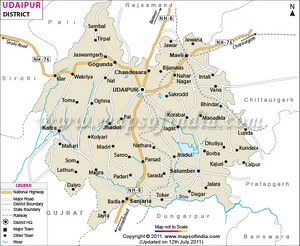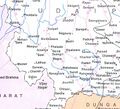Udaipur

Udaipur (उदयपुर) is a city and district in Rajasthan.
Variants
- Gihlot (गिहलौट) - ancient name of Udaipur.
Location
Udaipur is located in the southernmost part of Rajasthan, near the Gujarat border. It is surrounded by Aravali Range, which separates it from Thar Desert. It is around 655 km from Delhi and approximately 800 km from Mumbai, placed almost in the middle of two major Indian metro cities. Besides, connectivity with Gujarat ports provide Udaipur a strategic geographical advantage. Udaipur is well connected with nearby cities and states by means of road, rail and air transportation facilities. Udaipur is located at 24.525049°N 73.677116°E.
Tahsils in Udaipur District

History
It was the historic capital of the kingdom of Mewar. It was founded in 1559 by Maharana Udai Singh II of the Sisodia clan of Rajput,[1] when he shifted his capital from the city of Chittorgarh to Udaipur after Chittorgarh was besieged by Akbar. It remained as the capital city till 1818 when it became a British princely state,[2] and thereafter the Mewar province became a part of Rajasthan when India gained independence in 1947.[3]
Pre-Historic Era: The Ahar River bank was inhabited by men in about 2000 B.C. There are footprints of two different civilizations, which provides claims about earliest inhabitants of the Ahar culture: the Bhil/Bheels, the indigenous tribes originated at this place, and are still residing in the area in large numbers.
The Establishment of Udaipur as a city: Udaipur was founded in 1559,[4] by Maharana Udai Singh II[5] in the fertile circular Girwa Valley to the southwest of Nagda, on the Banas River. The city was established as the new capital of the Mewar kingdom. This area already had a thriving trading town, Ayad, which had served as capital of Mewar in the 10th through 12th centuries.[6] The Girwa region was thus already well known to Chittaud rulers who moved to it whenever the vulnerable tableland Chittaurgarh was threatened with enemy attacks. Maharana Udai Singh II, in the wake of 16th century emergence of artillery warfare, decided during his exile at Kumbhalgarh to move his capital to a more secure location. Ayad was flood-prone, hence he chose the ridge east of Pichola Lake to start his new capital city, where he came upon a hermit while hunting in the foothills of the Aravalli Range. The hermit blessed the king and guided him to build a palace on the spot, assuring him it would be well protected. Udai Singh II consequently established a residence on the site. In November 1567, the Mughal emperor Akbar laid siege to the venerated fort of Chittor. To protect Udaipur from External attacks, Maharana Udai Singh built a six kilometre long city wall, with seven gates,[7] namely Surajpole, Chandpole, Udiapole, Hathipole, Ambapole, Brahmpole and so on. The area within these walls and gates is still known as the old city or the walled city.
As the Mughal empire weakened, the Sisodia rulers, reasserted their independence and recaptured most of Mewar except for Chittor. Udaipur remained the capital of the state, which became a princely state of British India in 1818. Being a mountainous region and unsuitable for heavily armoured Mughal horses, Udaipur remained safe from Mughal influence despite much pressure.
Mewar State
The Udaipur State, also known as Mewar State,[8] was an independent state in northwestern India prior to the formation of the Indian Republic.
State formation: Mewar was founded by Bappa Rawal, formerly a chieftain of the Mori king of Chittor, who acquired control of Chittor in c.728.[9] Nagda was the first capital of Mewar and continued to be so until c. 948 when the ruler Allat moved the capital from Nagda, Rajasthan to Ahar.[10]
Mewar and the Mughals: In 1615, after four decades of skirmishing, Mewar and the Mughals entered into a treaty under which Mewar territory under the Mughals' possession was returned in exchange for the crown prince of Mewar attending the Mughal court and Mewar providing a force of 1,000 horsemen to the Mughals.[11]
Maratha influence: The Marathas made the first successful incursion into Mewar territory in 1725 and, subsequently, continued to exert increasing influence not only on Mewar but also surrounding states of Dungarpur, Banswara, and Bundi. To counter the Marathas, Maharana Jagat Singh of Mewar convened a conference of Rajput rulers in Hurda in 1734, but no agreement materialised. Maratha power continued to grow, with the Marathas regularly extracting hefty tributes from Mewar over the remaining part of the century. [12]
Mewar in the British Raj: By 1818, the armies of Holkar, Scindia, and Amir Khan had plundered Mewar, pauperising its ruler and people. As early as 1805, Maharana Bhim Singh of Mewar approached the British for assistance but the Treaty of 1803 with Scindia prevented the British from entertaining the request. But by 1817, the British too were anxious to have alliances with Rajput rulers and the Treaty of Friendship, Alliances and Unity was concluded between Mewar and East India Company (on behalf of Britain) on 13 January 1818.[13]
Under the treaty, the British Government agreed to protect the territory of Mewar, in return for which Mewar acknowledged British supremacy and agreed to abstain from political associations with other states and to pay one-fourth of its revenues as tribute for 5 years, and three-eight in perpetuity.[14] A constitution for Udaipur State was adopted on May 23, 1947.[15] The last ruler of Udaipur State signed the accession to Independent India on 7 April 1949.[16]
Maharanas of Mewar: Until 1303, the rulers of Mewar were called Maharawals. Upon the death of Maharawal Ratan Singh during the sack of Chittorgarh by Allauddin Khilji 1303, Hamir became the ruler of Mewar and styled himself as 'Maharana', which is what its rulers were called until dissolution of the state in 1949.[17]
उदयपुरविजयेन्द्र कुमार माथुर[18] ने लेख किया है ...उदयपुर (AS, p.96) मेवाड़ के महाराणा प्रताप के पिता सूर्यवंशी नरेश महाराणा उदयसिंह के द्वारा 16वीं शती में बसाया गया था। मेवाड़ की प्राचीन राजधानी चित्तौड़गढ़ थी। मेवाड़ के नरेशों ने मुग़लों का आधिपत्य कभी स्वीकार नहीं किया था। महाराणा राजसिंह जो औरंगज़ेब से निरन्तर युद्ध करते रहे थे, महाराणा प्रताप के पश्चात् मेवाड़ के राणाओं में सर्वप्रमुख माने जाते हैं। उदयपुर के पहले ही चित्तौड़ का नाम भारतीय शौर्य के इतिहास में अमर हो चुका था। उदयपुर में पिछोला झील में बने राजप्रासाद तथा सहेलियों का बाग़ नामक स्थान उल्लेखनीय हैं। उदयपुर परिचयउदयपुर शहर, दक्षिणी राजस्थान राज्य, पश्चिमोत्तर भारत में, अरावली पर्वतश्रेणी पर स्थित है। बंबई (अब मुम्बई) से 697 मील उत्तर उदयपुर-चित्तौर रेलवे के अंतिम छोर के पास स्थित उदयपुर नगर मेवाड़ के गर्वीले राज्य की राजधानी है। नगर समुद्रतल से लगभग दो हज़ार फुट ऊँची पहाड़ी पर प्रतिष्ठित है एवं जंगलों द्वारा घिरा है। प्राचीन नगर प्राचीर द्वारा आबद्ध है जिसके चतुर्दिक् रक्षा के लिए खाई खुदी है। पहाड़ी के ऊर्ध्व शिखर पर नाना प्रकार के प्रस्तरों से निर्मित महाराणा का प्रासाद, युवराज गृह, सरदार भवन एवं जगन्नाथ मंदिर दर्शनीय हैं। इनका प्रतिबिंब पचोला झील में पड़ता है। झील के मध्य में यज्ञ मंदिर एवं जलवास नामक दो जलप्रासाद हैं। स्थापना: महाराणा उदयसिंह ने सन् 1559 ई. में उदयपुर नगर की स्थापना की। लगातार मुग़लों के आक्रमणों से सुरक्षित स्थान पर राजधानी स्थानान्तरित किये जाने की योजना से इस नगर की स्थापना हुई। उदयपुर शहर राजस्थान प्रान्त का एक नगर है। यहाँ का क़िला अन्य इतिहास को समेटे हुये है। इसके संस्थापक बप्पा रावल थे, जो कि सिसोदिया राजवंश के थे। आठवीं शताब्दी में सिसोदिया राजपूतों ने उदयपुर (मेवाड़) रियासत की स्थापना की थी। उदयपुर के महाराणा का दरबार: उदयपुर को सूर्योदय का शहर कहा जाता है, जिसको 1568 में महाराणा उदयसिंह द्वारा चित्तौड़गढ़ विजय के बाद उदयपुर रियासत की राजधानी बनाया गया था। प्राचीर से घिरा हुआ उदयपुर शहर एक पर्वतश्रेणी पर स्थित है, जिसके शीर्ष पर महाराणा जी का महल है, जो सन् 1570 ई. में बनना आरंभ हुआ था। उदयपुर के पश्चिम में पिछोला झील है, जिस पर दो छोटे द्वीप और संगमरमर से बने महल हैं, इनमें से एक में मुग़ल शहंशाह शाहजहाँ (शासनकाल 1628-58 ई.) ने तख़्त पर बैठने से पहले अपने पिता जहाँगीर से विद्रोह करके शरण ली थी। सन 1572 ई. में महाराणा उदयसिंह की मृत्यु के बाद उनके पुत्र प्रताप का राज्याभिषेक हुआ था। उन दिनों एक मात्र यही ऐसे शासक थे जिन्होंने मुग़लों की अधीनता नहीं स्वीकारी थी। महाराणा प्रताप एवं मुग़ल सम्राट अकबर के बीच हुआ हल्दीघाटी का घमासान युद्ध मातृभूमि की रक्षा के लिए इतिहास प्रसिद्ध है। यह युद्ध किसी धर्म, जाति अथवा साम्राज्य विस्तार की भावना से नहीं, बल्कि स्वाभिमान एवं मातृभूमि के गौरव की रक्षा के लिए ही हुआ।
मेवाड़ राजस्थान के दक्षिण मध्य में एक रियासत थी। मेवाड़ को उदयपुर राज्य के नाम से भी जाना जाता था। इसमें आधुनिक भारत के उदयपुर, भीलवाड़ा, राजसमंद, तथा चित्तौडगढ़ ज़िले थे। सैकड़ों सालों तक यहाँ राजपूतों का शासन रहा और इस पर गहलौत तथा सिसोदिया राजाओं ने 1200 साल तक राज किया था। अलाउद्दीन ख़िलजी ने 1303 ई. में मेवाड़ के गहलौत राजवंश के शासक रतनसिंह को पराजित कर मेवाड़ को दिल्ली सल्तनत में मिलाया। गहलौत वंश की एक शाखा 'सिसोदिया वंश' के हम्मीरदेव ने मुहम्मद तुग़लक के समय में चित्तौड़ को जीत कर पूरे मेवाड़ को स्वतंत्र करा लिया। 1378 ई. में हम्मीदेव की मृत्यु के बाद उसका पुत्र क्षेत्रसिंह (1378 -1405 ई.) मेवाड़ की गद्दी पर बैठा। क्षेत्रसिंह के बाद उसका पुत्र लक्खासिंह 1405 ई. में सिंहासन पर बैठा। लक्खासिंह की मृत्यु के बाद 1418 ई. में इसका पुत्र मोकल राजा हुआ। मोकल ने कविराज बानी विलास और योगेश्वर नामक विद्वानों को आश्रय दिया। उसके शासनकाल में माना, फन्ना और विशाल नामक प्रसिद्ध शिल्पकार आश्रय पाये हुये थे। मोकल ने अनेक मंदिरों का जीर्णोद्धार कराया तथा एकलिंग मंदिर के चारों तरफ परकोटे का भी निर्माण कराया। उसकी गुजरात शासक के विरुद्ध किये गये अभियान के समय हत्या कर दी गयी। 1431 ई. में उसकी मृत्यु के बाद राणा कुम्भा मेवाड़ के राज सिंहासन पर बैठे। अम्बाजी नाम के एक मराठा सरदार ने अकेले ही मेवाड़ से क़रीब दो करोड़ रुपये वसूले थे। संदर्भ: भारतकोश-उदयपुर गिहलौटविजयेन्द्र कुमार माथुर[19] ने लेख किया है ...[p.289]: गिहलौट मध्यकाल में चित्तौड़ के निकट अरावली पर्वत की घाटी में बसा हुआ एक अति प्राचीन स्थान है, जो बाद में उदयपुर कहलाया। मेवाड़ की प्राचीन जनश्रुतियों के अनुसार मेवाड़-नरेशों के पूर्वज बप्पारावल ने चित्तौड़ को विजय करने से पहले इसी स्थान के निकट कुछ समय तक अज्ञातवास किया था. गहलोत राजपूतों का आदि निवास-स्थान भी यहीं था. इस स्थान का नामकरण गुहिल जाति के यहाँ मूलरूप से निवास करने के कारण हुआ था। बप्पा का संबंध बचपन में इन्हीं लोगों से रहा था (गुहिल=गुह). सन 1567 ई. में जब अकबर ने चित्तौड़ पर आक्रमण किया, तो महाराणा उदयसिंह राजधानी छोड़कर गिहलौट में जाकर रहे थे। उन्होंने प्रारम्भ में यहाँ एक [p.290]: पहाड़ी पर सुन्दर प्रासाद का निर्माण करवाया था। धीरे-धीरे यहाँ कई महल बनवाये तथा यहाँ पर निवासियों की संख्या भी बढ़ने लगी। जल्दी ही इस जंगली गाँव ने एक सुन्दर नगर कारूप धारण कर लिया। इसी का नाम कुछ समय पश्चात् उदयसिंह के नाम पर उदयपुर हुआ और उदयसिंह ने मेवाड़ राज्य की राजधानी चित्तौड़ से हटा कर इस नये नगर में बनायी गयी। देवरी उदयपुरविजयेन्द्र कुमार माथुर[20] ने लेख किया है ...देवरी (AS, p.450) उदयपुर ज़िला, राजस्थान का एक ऐतिहासिक स्थान है। यह स्थान उदयपुर के निकट स्थित है। देवरी की घाटी में एक भयंकर युद्ध के पश्चात् मुग़लों को बड़ा भारी नुकसान उठाना पड़ा था। मेवाड़ के महाराणा राजसिंह ने देवरी पर मुग़ल सम्राट औरंगज़ेब की सेना का आक्रमण विफल कर दिया था। मुग़ल सम्राट ने महाराणा को मारवाड़ के राजकुमार अजीत सिंह को शरण देने तथा जज़िया कर के विरुद्ध कार्रवाई करने के लिए दोषी ठहराया था। मारवाड़ के वीर दुर्गादास की कूटनीति के फलस्वरूप देवरी की घाटी में मुग़ल सेना फंस गई तथा उसका बड़ा भाग नष्ट हो गया। Notable persons
External linksGalleryReferences
Back to Rajasthan |
||||||||||||||||||||||||||||||||||||||||||||||||||||||||||||||||||||||||||||||||||||||||||||||||






